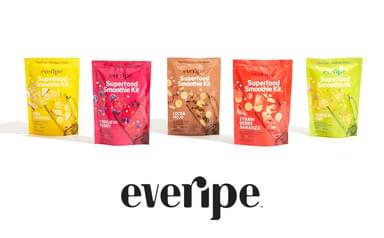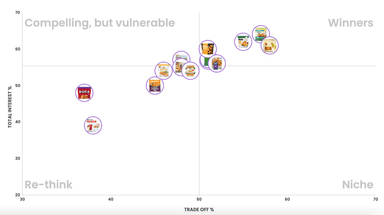Innovation in product lines and product development requires persistence. A lot of it. For instance, it took Thomas Edison 1,000 failed attempts before he could make his first lightbulb.
But what if we told you that there is something that can help you make this sometimes daunting process easier? Something that can tell you exactly what you did right and wrong, and where your new product shines.
Spoiler: that something is concept validation.
What is concept validation?
Concept validation (sometimes known as concept testing) helps you assess the viability of your product ideas before they enter the real world.
Whether you’re at the early product development stage, or want to rejig your existing product concept for a specific target audience, concept testing is your best way to accurately predict the performance of your new idea in-market.
Why should concept validation be part of your product development plan?
Concept validation should be part of your product development plan because it helps you to ensure your product is right for market earlier on.
1. You’ll Save Money
Concept validation will save you money, and make you more money, because you’re minimizing risk and optimizing for success when the concept comes to life in-market.
2. To Develop Proof Points
Persuading team members and key stakeholders of the potential of your product innovation becomes easier when your concept validation metrics quantify that exact potential.
3. To Build Confidence
Concept validation will get rid of the guesswork and give you the confidence to choose ideas with a better product-market fit.
Read more: 5 Reasons to do Concept Testing in Marketing Research
A real-life example of why concept validation works
Everipe, an up-and-coming startup that produces nutrient-rich smoothies in a freeze-dried format, wanted to know if there was a potential for a new product line in a competitive smoothie sector.

The brand then used Upsiide’s concept testing methodology to validate the new product idea and prove its market potential to key stakeholders and investors. Our Concept Testing solutions allowed them to see how they measure up to the competition and which elements of their smoothies excited potential customers the most.
In the end, Everipe felt confident about their product concept and finalized their investment decisions to bring the smoothies to life.
How do I validate my new concepts?
Concept testing sounds like a complicated task. It’s easy to get overwhelmed. That’s why we came up with these simple steps for validating a product idea to help you make this process a little less intimidating.
1. Jot down all your ideas
Think of what it is that you want to test in your product - functionality, appearance, in-market appeal… These will depend on the kind of product concept you have in mind (e.g. testing a new app feature will be different from testing a new flavour).
It helps if you group your ideas into clusters, so you can easily put them in your survey plan. For instance, if you want to test different soda flavours, these flavour ideas can be put into one group.
2. Plan your product validation survey questions
Once you have your ideas ready, think of how you want to structure your questionnaire.
Some questions you need to ask yourself are:
What are the main objectives of your concept testing study?
Think of what you want to achieve by the end of the concept validation process. It’s good to have a few hypotheses about your consumer personas, so the study could show you if you were right.
Hot tip: testing your concept ideas against existing products or offers in the market is a great way to benchmark the actual potential of your new idea or ideas.
How should you test the ideas?
Depending on your objectives, the format in which you validate your concepts will vary. For instance, if you have some visual product mock-ups, include these images in your test and see how people react.
Hot tip: You might want to do a usage & attitudes questionnaire to learn more about your target market prior to launching a concept validation survey. This will allow you to tailor the survey more specifically to the demographics and psychographics that are most relevant - which makes the process of writing a concept much easier.
Once you have answers to these questions, you will have a better sense of what you want to validate. Then, you can start building your study.
Product validation survey question examples:
How do you feel about this product?
How likely are you to buy this product?
Is everything about this product clear andeasy to understand?
Is everything about this product believable?
What do you like about this product?
What do you dislike about this product?
Please imagine for a moment the person who will like this product. Are they old, young, male, female? What other sorts of things do they like?
These kinds of product validation survey questions will help you understand more details about your concept. We have a great article on the best practices for writing concept testing survey questions, so be sure to apply them next time you create a questionnaire.
3. Set up your study and launch
Programming a study by yourself is not that hard if you have the right tools and guidance at hand.
At Upsiide, the user experience is so simple and easy you won’t struggle to understand how to build the study. And we’ve got Templates that guide you through the set up. You can create questions, set up audience demographic details, launch studies and get results in a matter of hours.
4. Choose and prioritize your product concepts
Now that your study is back, it’s time to crunch the numbers.
It’s tempting to just choose the best-performing ideas and be done with it. But trust us, it’s not the best practice.
While it’s great to look at the most popular concepts, it’s also worth looking at concepts that didn’t do so well. Ask yourself, why did that happen and where can I improve? Use demographic and custom filters to find patterns across distinct audience groups.
Sometimes, you find ideas that didn’t do so well with the general sample but were extremely well received by a specific group of respondents.
Upsiide’s charts can map out your ideas based on people’s interest and commitment and show you which ideas you should pursue next.

Have a look at the goals you made in Step 1 and come up with criteria that you will use to prioritize your ideas efficiently. Some things you could look at are:
Revenue potential
Consumers’ purchase intent
Market appeal
Competitive potential
All of these things will help you determine which ideas are worth pursuing and which ones are not.
It’s worth noting that the latter group, including those ideas that don’t make sense to move forwards with right now, doesn’t need to be eliminated. Perhaps, you could create an internal folder with ideas that could be improved in the future when you have more time and resources.
5. Iterate, iterate, and iterate!
If you remember one thing from this guide, make it this. Concept validation is not a one-time thing.
To make sure that you stay on top of market trends, it’s best to repeat the process regularly to see how your products can be improved to best meet consumer needs.
Some companies even adopt innovation cycles to have their finger on the pulse all the time. They do that thanks to automated research platforms that allow you to program study templates, so the process is quick and efficient.
Concept validation will make your life easier.
It might have taken over 1,000 tries for Edison to make a lightbulb. But innovation doesn’t need to be this complicated, especially when you have new (and, hopefully, more modern) ways to make that happen.
Concept validation is one of the ways to make life easier. It can help you streamline your product development process, getting to market faster.




